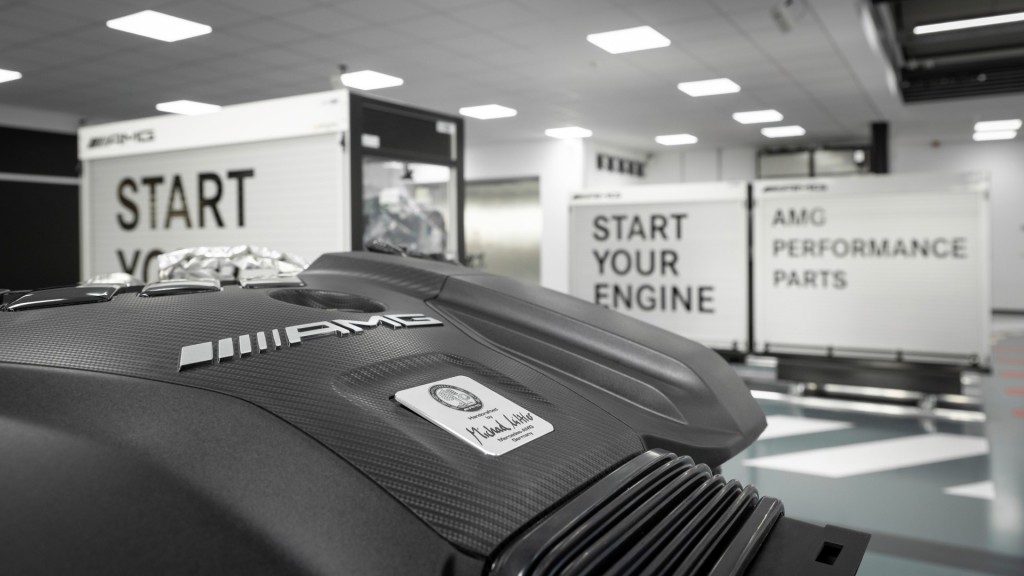At 160.5kg, the newly configured 1,991cc single-turbo engine has a 7,200rpm redline and a compression ratio of 9.0:1 and a maximum charge pressure of 1.9 bar as standard.
It comes equipped with 16-valves with eight designated for intake that's controlled by a dedicated adjustable camshaft.
The remaining eight valves help exhaust exit the engine more optimally via a CAMTRONIC valve timing adjustable camshaft that helps improve flow dynamics.
Fuel is sent into the combustion chamber at a maximum charge pressure of 1.9 bar via a combination of modern direct injection and old-school manifold injectors that come with solenoid valves to help minimise carbon build-up on the intake valves.
The basic engine is capable of producing 387hp at 6,500rpm and 480Nm of torque from 4,750 to 5,000rpm.
The uprated S engine, however, is able to move more air at 1,200kg per hour into the engine and sends fuel into the combustion chamber at a higher maximum charge pressure of 2.1 bar.
This helps to increase the engine's output to 421hp at 6,750rpm and 500Nm of torque from 5,000 to 5,250rpm.
The new engine is entirely assembled by hand on the first floor of the AMG engine manufactory in Affalterbach, Germany with a newly implemented Industry 4.0 for the company's "One Man, One Engine" principle.
Compared to the transversely installed M 260 four-cylinder engine in the "35" models or the preceding M 133 engine, the new M 139 is rotated around its vertical axis by 180 degrees.
This means that the turbocharger and exhaust manifold are now facing the firewall to allow for an improved air ducting with shorter distances and fewer diversions - both on the intake and exhaust side.
The M 139's turbine housing is divided into two flow passages which run parallel to one another.
Together with the divided ducts in the exhaust manifold, the exhaust flow can be fed separately to the turbine to prevent individual cylinders from influencing each other negatively during load cycles.
In turn, this helps to improve the gas cycle resulting in higher torque readings at lower engine speeds and good responsiveness.
Furthermore, the shafts of the compressor and turbine have roller bearings for the first time ‑ as in the top output variant of the AMG 4.0-litre V8 engine in the AMG GT 4-door Coupé.
These reduce mechanical friction within the turbocharger to a minimum and is capable of responding more readily as well as reach a maximum speed of up to 169,000rpm in a shorter time span.
With a maximum charge pressure of 2.1 bar (1.9 bar in the basic version), the electronically controlled wastegate (exhaust relief valve) allows the charge pressure to be controlled more precisely and flexibly while optimising responsiveness, especially when accelerating from partial load.
The main input signals for the wastegate control unit are the charge pressure, throttle flap position and the knocking tendency.
The modifying signals include the intake air temperature, engine temperature, engine speed and atmospheric pressure to make temporary boosting of the charge pressure (overboost) possible under acceleration.
Fresh air is used in addition to oil and water to cool the turbocharger.
This is directed specifically to the charger from the radiator grille, via the engine cover designed as an air deflector and ducts beneath the bonnet.

The all-aluminium crankcase is a chill-cast unit. The areas around the cylinders are mostly solid, and the cover plate is only penetrated by smaller ducts for the coolant and engine oil.
The crank assembly with a lightweight, forged steel crankshaft and forged aluminium pistons with optimised piston rings combines low friction with high strength.
The sump features baffle plates so that despite the larger sump, and even under high lateral acceleration forces, there is always sufficient engine oil to lubricate all relevant components.
To reduce friction between the pistons and cylinder walls, the linings are coated with patented NANOSLIDE technology for a mirror-like surface that provides minimal friction and is twice as hard as conventional grey cast-iron liners.
Developed by Daimler AG, Nanoslide was first used for AMG's M 156 engine as well as other AMG engines including Formula 1.
Repositioning and slightly angling the injection nozzles and spark plug system in the cylinder head made it possible to greatly enlarge the exhaust valves compared to those of the preceding M 133 engine.
The larger exhaust cross-sections allow the gases to stream out of the combustion chambers with low losses and reduce the overall piston venting action.
More efficient cylinder head cooling was achieved by seating rings with a reduced installed height and a cooling borehole near the combustion chamber, in the web area between the exhaust seating rings.
The cooling performance was also improved by a near-surface water jacket geometry, a faster flow rate and an optimised volumetric flow rate.
Turbocharging and direct injection with a spray-guided combustion process not only allow a high power yield but also improve thermodynamic efficiency and therefore reduce both fuel consumption and exhaust emissions.
Cooling of the transmission oil is integrated into the engine's coolant circuit and is assisted by a heat exchanger mounted directly on the transmission. The engine control unit is mounted on the air filter housing, where it is cooled by airflow.
The demand-controlled, electric high-performance water pump operates independently of the engine speed.
Late activation during warm-up means that the engine block warms up more rapidly, with a positive effect on friction, consumption and emissions.
The pump can also be switched on or off as required when driving under less power or at low engine speeds.
Furthermore, the electric water pump ensures the full engine output and optimum heat dissipation over the entire engine speed range.
It also protects against thermal damage when idling in very high ambient temperatures.
Functions such as alternator management, the ECO start/stop function with fast restarting, the gliding function and a petrol particulate filter are also part of the technology package for the new AMG four-cylinder.










